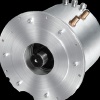|
EXPLORING ELECTRIC VEHICLE ADOPTION IN NEW YORK CITY
PlaNYC, the City’s comprehensive sustainability plan, established
an aggressive strategy to reduce the City’s greenhouse
gas emissions in 2030 by 30% from 2005 levels. As part of that
overall goal, transportation emissions, which currently account
for 22% of New York City’s total greenhouse gas emissions,
would be reduced by 44% by 2030. PlaNYC also targeted a reduction
in the city’s levels of harmful particulate emissions and
pollutants, to improve New York City’s air quality.
Public transportation, bicycling, and walking are critical elements
of the City’s sustainable transportation system. In addition
to using fewer automobiles, the City can also become
more sustainable by making existing vehicles more effi cient. In
recent years, automotive manufacturers have begun to develop
and produce a new generation of vehicles that are more
energy effi cient, emit fewer emissions, and use little or no gasoline.
Among the most promising of these technologies are
those that rely on electricity, either to enhance the distance a
vehicle can travel before consuming gasoline, or through an
entirely electric operation relying on battery storage technology.
For those New Yorkers that will continue to rely on the
automobile for their mobility needs, these electric vehicles can
offer an improvement over gasoline vehicles in reducing both
urban pollution and greenhouse gas emissions, helping to
meet the City’s PlaNYC targets. And, although they are currently
more expensive to purchase than gasoline-powered vehicles,
electric vehicles offer the potential to save drivers signifi cant
sums of money over time, in fuel and maintenance savings – by
some estimates, electric vehicles may be 40% to 70% cheaper
to operate, depending on gasoline prices and how far a driver
travels each year.
In the last year, discussion of electric vehicles (EVs) has become
increasingly prominent in the United States. Manufacturers
have announced more than a dozen highway-capable electric
vehicle models for introduction between 2010 and 2012. The
Obama administration has committed more than $4 billion in
support of the design, manufacture, and purchase of electric
vehicles. And regulations requiring vehicle fuel effi ciency are
being strengthened in the U.S., effectively mandating the introduction
of advanced vehicle technologies.
While electric vehicle technology offers the promise of reducing
emissions of criteria pollutants and CO2, New York City’s
unique transportation profi le requires a tailored strategy to
promote the adoption of EVs. Most New Yorkers do not own a
car, and those who do may not drive them as far, or as frequently,
as in other parts of the country. In addition, many New
Yorkers park their cars on the street or in commercial garages.
As a result, it is unclear who the target market for the fi rst EVs
would be in New York City, how many EVs would be purchased,
what the key factors and barriers would be for early adoption,
and how EV usage would impact our electrical grid. It is also
not clear what incentives – infrastructure investments, subsidies,
or other actions – may be needed to promote EVs.
read more
|
|
Какъв автомобил бихте закупили?

|
Януари 2026
|

|
|
| Нед |
Пон |
Вто |
Сря |
Чет |
Пет |
Съб |
| | | | | | | | | | | | | | | | | | | | | | | | | | | | | | | | | | | |
|














